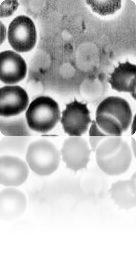

PARP-1 and PARP-2 belongs to a large family of enzymes that, using NAD+ as a substrate, synthesizes and transfers ADP-ribose onto aspartic and glutamic acid residues of acceptor proteins, including PARPs, histones, transcription factors and DNA repair proteins.
Poly-ADP-ribosylation is terminated by the release of extensively poly-ADP-ribosylated (negatively charged) PARP molecules from DNA. ADP-ribose polymers are then subjected to degradation by poly-ADP-ribose-glycohydrolase. Poly(ADP-ribosyl)ation is therefore an immediate, covalent, but transient post-translational modifications of nuclear proteins, induced by DNA lesions. In addition, it has been suggested that other signals than DNA lesions, including steroid hormones, stress, and infection, may also activate PARP molecules at specific chromosome sites.
The physiological function of PARP-1 as well as other members of the PARP family is still under debate or investigation. An important tool for the analysis of this issue has been the development of PARPs knockout mice (PARP-1-/-, PARP-2-/-). Using these animal models a large body of evidence has implicated PARP-1 in the regulation of DNA repair and transcriptional activity of eukaryotic genes. PARP-1 might modulate gene expression through different mechanisms:
Thus, PARP-1 might plays a critical role as a signaling molecule, which controls the expression of multiple genes involved in the inmmune response. However, analysis of residual basal poly(ADP-ribosyl)ation in PARP-1-/- tissues have demonstrated a high percentage of PARP activity in thymus (31% activity) and spleen (82%activity). The majority of this activity seems to be related to PARP-2. However very limited information is available about the role plays by PARP-2 in physiological and pathophysiological conditions. More recently, it has been identified specific and essential roles of PARP-2 in spermatogenesis, and T cell development.
The aim of this project is to investigate the role of poly(ADP-ribosyl)ation of nuclear proteins, catalysed by PARP family members (specially PARP-1 and PARP-2), as a critical signaling pathway at nuclear level, in both innate and adquire immune response. The results from this study could allow identifying new therapeutic target in different pathophysiological conditions associates with the immune system.
Coordinator:
José Yelamos(ELIMINAR)
Tel:
93 316 04 11
Fax:
93 316 04 10
Dr. Aiguader, 88
08003 Barcelona
© Institut Hospital del Mar
d'Investigacions MèdiquesLegal Notice and Privacy Policy | Cookie Policy | Site Index | Accessibility | Find Us | Contact